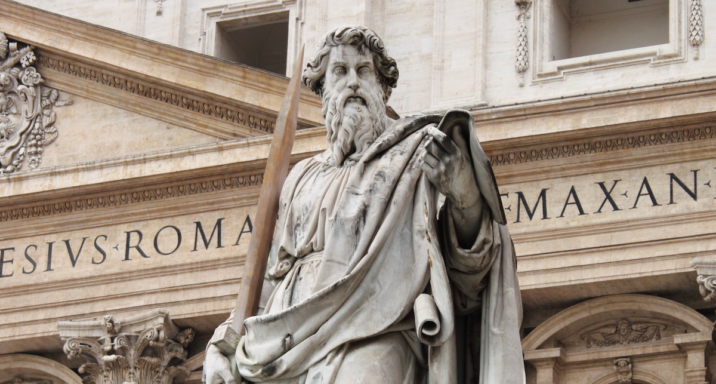In this first of a two-part article excerpted from Understanding the Jewish Roots of Christianity: Biblical, Theological, and Historical Essays on the Relationship between Christianity and Judaism, David Rudolph considers the sometimes hotly contested debate about Paul and the law and whether he was championing a new freedom from—or end to—Jewish law.
***
The “Paul and the law” debate has been ongoing since the time of Paul, and there is no sign of it winding down. One person quotes Romans 10:4, “Christ is the end of the law,” while another responds with 1 Timothy 1:8, “We know that the law is good if it is used properly.” Back and forth, like a table-tennis game, the discussion continues. Is there anything new worth saying on the subject of Paul and the law? Many do not think so, and so commentaries recycle the same arguments that have been made for almost 2,000 years.
While I cannot claim to have discovered some secret knowledge that will cause everyone to agree on the issue of Paul and the law, I do have an observation to share that I think has the potential to cut through the morass surrounding the specific question of whether Paul was championing a new freedom from—or end to—Jewish law for Jewish people.
Here is my little observation that actually makes a big difference.
The issue of Paul and the law
It is that among all the texts that address the issue of Paul and Jewish law, not all of these texts are equal. There are several texts that are weightier than the rest, and we should privilege these texts. To followers of Jesus, I realize this may sound highly unorthodox, since we are used to thinking of all Scripture being the same in value. After all, Paul himself says in 2 Timothy 3:16, “All Scripture is God breathed.” While that is certainly true, I would argue that some parts of Scripture have greater weight than others when weighing in on the subject of Paul’s view of Jewish law as it applies to Jewish people.
The notion that some parts of Scripture have greater weight than others is not foreign to Jewish thinking. In fact, it is normative. The Torah is the foundational revelation of God, and the prophets and apostles of Israel consistently refer back to the five books of Moses in order to validate later revelation. Similarly, the four Gospels function as a kind of foundational revelation within the New Testament corpus. The Jewish authors of the apostolic writings regularly point back to the life, death, and resurrection of Yeshua [Jesus]—the life-giving story that is told in the four Gospels. As Jonathan Pennington concludes in his book Reading the Gospels Wisely:
I raise this issue of a “canon within a canon” and its unavoidability because in this concluding chapter I want to make a bold suggestion: namely, we should have a conscious canon within the canon, that is, a group of texts that guide and direct our overall reading of Scripture. And if you’ve read this far, you are probably not surprised that I believe this group of guiding texts is none other than the fourfold witness of the Gospels. I am suggesting not that the Gospels in any way exclude or mitigate against the witness of the rest of the Scriptures, but that they do hold a privileged place and controlling position. . . . It seeks to recognize that not all writings are meant to be as comprehensive and universally applicable as others; some writings simply have more weight than others, and some texts and ideas provide guiding light to understanding other ideas.1
If this is accurate, and I think it is, then the next logical question to ask is: What are the weightier texts that address the issue of Paul’s view of Jewish law in relation to Jewish people? And what should be our basis or criterion for deciding which texts are given this privileged status?
In answering the second question first, I propose that the criterion for identifying a weightier text should be that the text itself or the context of the text calls out for the text to be privileged. Let me put it in more personal terms. If your writings sparked controversy, and people were interpreting them in different ways, in some cases misinterpreting them, what would you say to communicate that you are now setting the record straight? How would you drive home the point that you are about to clarify everything and bring closure to the controversy? Maybe you would say, “I am now setting the record straight concerning this.” This would be the cue that what you are about to share has a special status, since it is your intention for this clarification to interpret your previous work. And even if there were to be further misunderstanding for whatever reason, the fact remains that by giving the clarification, you have taken the initiative to set the record straight.
In the same way, there are Pauline texts, and texts about Paul, that essentially cry out with the words, “I am now setting the record straight.” These are the weightier texts. These are the closure texts. These are the final word texts, the full-stop texts. These are the texts that we should give special attention to in our discussion of Paul’s view of Jewish law in relation to Jewish people.
What did Paul teach about Jewish law for Jewish people?
There are at least three texts in the Pauline corpus and Acts that, in my opinion, rise to the level of communicating the equivalent of the words: “I am now setting the record straight concerning what Paul teaches about Jewish law for Jewish people.” One of these texts lays down an apostolic “rule” for all of Paul’s congregations, another is the ruling of an apostolic council, and the final text describes a public testimony before witnesses on the level of an oath.
1. 1 Corinthians 7:7–20
The first text, which represents an apostolic rule, is 1 Corinthians 7:17–20.2
Here Paul writes: “This is my rule in all the churches. Was anyone at the time of his call already circumcised? Let him not seek to remove the marks of circumcision. Was anyone at the time of his call uncircumcised? Let him not seek circumcision. . . . Let each of you remain in the condition in which you were called” (NRSV).What is a rule? The Greek word diatassomai in 1 Corinthians 7:17 refers to “detailed instructions as to what must be done.”3
Rules are made to avoid misunderstandings and ambiguities. A rule is an authoritative bottom line. In the biblical context, a rule can be a single text of Scripture that is given a special status in the canon because it serves as a guide for interpreting other passages of Scripture. For example, the golden rule, which echoes Hillel’s rule (b. Shabb. 31a), helps us not to miss the forest for the trees in our understanding of God’s Word. It states, “So in everything, do to others what you would have them do to you, for this sums up the Law and the Prophets” (Matt. 7:12 NLT).
Another example is how the Septuagint (the ancient Greek translation of the Torah) and the Nash Papyrus introduce the Shema (Deut. 6:4–5) with a verse that is not found in the Masoretic Text: “These are the laws and the rulings which Adonai commanded Israel in the desert when they left Egypt,” thus ascribing special weight to the Shema. Jesus does something similar when he says: “‘You shall love the Lord your God with all your heart, and with all your soul, and with all your mind.’ This is the greatest and first commandment. And a second is like it: ‘You shall love your neighbor as yourself.’ On these two commandments hang all the law and the prophets” (Matt. 22:37–40 NRSV). In the first century CE, various Jewish sects had rules that established community norms, such as Serekh ha-Yakhad, also known as 1QS (Community Rule) at Qumran.
In 1 Corinthians 7, Paul’s bottom line, his rule in all the churches, is that the circumcised are to remain circumcised and not become uncircumcised. Here “circumcision” is a metonymy for Jewish identity and lifestyle. Paul is saying, “If you are Jewish, stay Jewish, and do not stop being Jewish (i.e., don’t assimilate).” This is Paul’s rule—not just in Corinth but in all of his congregations.
Why does Paul refer to Jews as “the circumcised”? It is because circumcision “was not merely a single act of law-keeping. It was the first act of full covenant membership and obligation. ‘Circumcision’ could stand metonymically for a whole people precisely because it characterized a people’s whole existence, a complete way of life.”4
Romans 2:25 and Galatians 5:3 confirm that Paul linked circumcision to law observance. He writes in Romans 2:25—“Circumcision indeed is of value if you obey the law; but if you break the law, your circumcision has become uncircumcision” (NRSV). In Galatians 5:3, Paul makes the same point in more explicit language—“Once again I testify to every man who lets himself be circumcised that he is obliged to obey the entire law” (NRSV).
Paul’s peculiar wording in 1 Corinthians 7:18—“Let him not seek to remove the marks of circumcision”—is a Jewish idiom in the Greek that points back to the Maccabean period, when many Hellenistic Jews rejected their Jewish identity, even to the extent of surgically altering their bodies so that they appeared to have a foreskin. First Maccabees 1:11–15 describes Jews who removed the marks of circumcision as “those who abandoned the holy covenant.”5As a first-century Jew, Paul would have celebrated Hanukkah. During this festival, the story of 1 Maccabees was recounted and Jews were reminded to follow the example of the Maccabees, who remained faithful to God’s Torah, in contrast to the apostate Jews who removed the marks of circumcision. This is the imagery that Paul is invoking in 1 Corinthians 7. He also describes Jewish identity as a God-given “calling” (klēsis) in 1 Corinthians 7:20.6
In sum, Paul’s bottom line, his rule, is that Jews who follow Jesus, like Paul himself, should remain in their calling as Jews and not assimilate.
2. Acts 15
A second text that sets the record straight on the matter of Paul’s view of Jewish law in relation to Jewish people is the Acts 15 Jerusalem Council decision. The weightiness of this text derives from its being the ruling of a first-century apostolic council. Luke writes:
Then the apostles and elders, with the whole church, decided to send men chosen from among them, Judas called Barsabbas and Silas, leaders among the brothers, to Antioch with Paul and Barnabas. They sent this letter with them:
“From the apostles and elders, your brothers, to the Gentile brothers and sisters in Antioch, Syria, and Cilicia, greetings! Since we have heard that some have gone out from among us with no orders from us and have confused you, upsetting your minds by what they said, we have unanimously decided to choose men to send to you along with our dear friends Barnabas and Paul, who have risked their lives for the name of our Lord Jesus Christ. Therefore we are sending Judas and Silas who will tell you these things themselves in person. For it seemed best to the Holy Spirit and to us not to place any greater burden on you than these necessary rules: that you abstain from meat that has been sacrificed to idols and from blood and from what has been strangled and from sexual immorality. If you keep yourselves from doing these things, you will do well. Farewell.” (Acts 15:22–29 NET)
While the significance of the Jerusalem Council decision for exempting gentile believers from proselyte circumcision and full Torah observance has long been recognized in New Testament studies, the implications for Jewish believers in Jesus has only recently become a topic of discussion in Acts scholarship. As F. Scott Spencer points out, “The representatives at the Jerusalem conference—including Paul—agreed only to release gentile believers from the obligation of circumcision; the possibility of nullifying this covenantal duty for Jewish disciples was never considered.”7
Moreover, if the Jerusalem leadership had viewed circumcision as optional for Jesus-believing Jews, there would have been no point in debating the question of exemption for Jesus-believing gentiles or delivering a letter specifically addressed to these gentiles. Michael Wyschogrod rightly notes that “both sides agreed that Jewish believers in Jesus remained obligated to circumcision and the Mosaic Law.”8
A growing number of New Testament scholars now concur with Wyschogrod that an important implication of the Jerusalem Council decision is that Jesus-believing Jews were to remain practicing Jews. It is notable that Paul not only participated in the council’s deliberations but also delivered its ruling, the apostolic decree, to the gentile churches (Acts 15:30–31; 16:4).
While the historical reliability of Acts is a debated question in New Testament studies today, the historic Church from the earliest times has included Acts in the Church’s canon of Scripture, with the framers of the canon intentionally placing it before the letters of Paul. Ecclesial theology, therefore, marches to the beat of a different drummer than many in New Testament studies. Ecclesial theologians, above all, should recognize the weight of this first church council, which was convened by the apostles to set the record straight regarding the role of Jewish law in the life of the church. The Jerusalem Council, which preceded the First Council of Nicaea by almost 300 years, should have a unique authority in ecclesial theology to weigh in on the question of Paul’s view of Jewish law in relation to Jesus-believing Jews.
***
In Part 2 of this article, David Rudolph continues to explore the debate about Paul and the law, beginning with the third text he believes Paul used to “set the record straight” as to whether he was championing a new freedom from—or end to—Jewish law.
This article is adapted from Understanding the Jewish Roots of Christianity: Biblical, Theological, and Historical Essays on the Relationship between Christianity and Judaism by David Rudolph, available now from Lexham Press.
Related articles
- How to Discover Current Dates for Jewish Feasts
- Jacob Neusner: 4 Reasons to Read this Jewish Studies Author
- The Jewish Trinity and Why the Old Testament is a Bridge to Faith
- What Is the Pentateuch? Plus 15 Best Commentaries for Studying It
- How Modern-Day Christians Should Approach Old Testament Law
Helpful resources
- Reading the Gospels Wisely by Jonathan Pennington
- Paul and Pauline Theology (15 vols.) by David Rhoads, et al.
- Cultural Concepts Collection (37 resources)
- The Works of Josephus by William Whiston; Josephus
- Library of Second Temple Studies (2 vols.)
- Paul and the Jews by A. Andrew Das
- Jonathan T. Pennington, Reading the Gospels Wisely: A Narrative and Theological Introduction (Grand Rapids: Baker, 2012), 230, 249.
- See David J. Rudolph, “Paul’s ‘Rule in All the Churches’ (1 Cor 7:17–24) and Torah-Defined Ecclesiological Variegation,” Studies in Christian-Jewish Relations 5 (2010): 1–23; Rudolph, A Jew to the Jews: Jewish Contours of Pauline Flexibility in 1 Corinthians 9:19–23 (Tübingen: Mohr-Siebeck, 2011), 75–88.
- Johannes P. Louw and Eugene A. Nida, eds., Greek-English Lexicon of the New Testament Based on Semantic Domains (New York: United Bible Societies, 1989), 33.325; Frederick W. Danker, ed., A Greek-English Lexicon of the New Testament and Other Early Christian Literature, 3rd ed. (Chicago: University of Chicago Press, 2000), 237.
- James D. G. Dunn, “Neither Circumcision nor Uncircumcision, but … (Gal. 5.2–12; 6.12–16; cf. 1 Cor. 7.17–20),” in La Foi Agissant par L’amour (Galates 4,12–6,16), ed. A Vanhoye (Rome: Benedictina, 1996), 86. See 1 Macc. 1:48, 60–61; 2:46; 2 Macc. 6:10; Josephus, Ant. 13.257–58, 318; Jub. 15.25–34.
- “In those days certain renegades came out from Israel and misled many, saying, ‘Let us go and make a covenant with the Gentiles around us, for since we separated from them many disasters have come upon us.’ This proposal pleased them, and some of the people eagerly went to the king, who authorized them to observe the ordinances of the Gentiles. So they built a gymnasium in Jerusalem, according to Gentile custom, and removed the marks of circumcision, and abandoned the holy covenant” (1 Macc. 1:11–15).
- See Paul’s use of klēsis in Rom 11:28–29, where he here links the irrevocable klēsis of Israel with the reception of God’s “gifts.” Most commentators agree that Paul here alludes back to Rom 9:4–5, where he lists (in the present tense) the gifts of God to Israel, which include the law and covenants.
- Scott Spencer, Acts (Sheffield: Sheffield Academic, 1997), 159.
- Michael Wyschogrod, Abraham’s Promise: Judaism and Jewish-Christian Relations, ed. R. Kendall Soulen (Grand Rapids: Eerdmans, 2004), 194.







